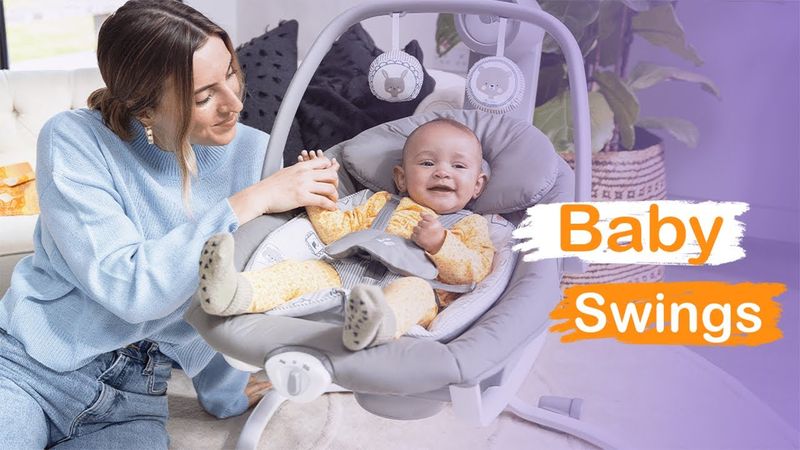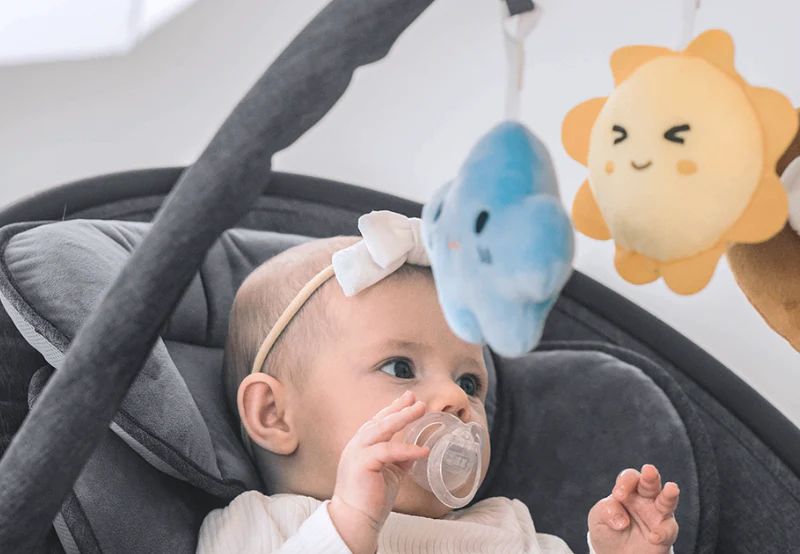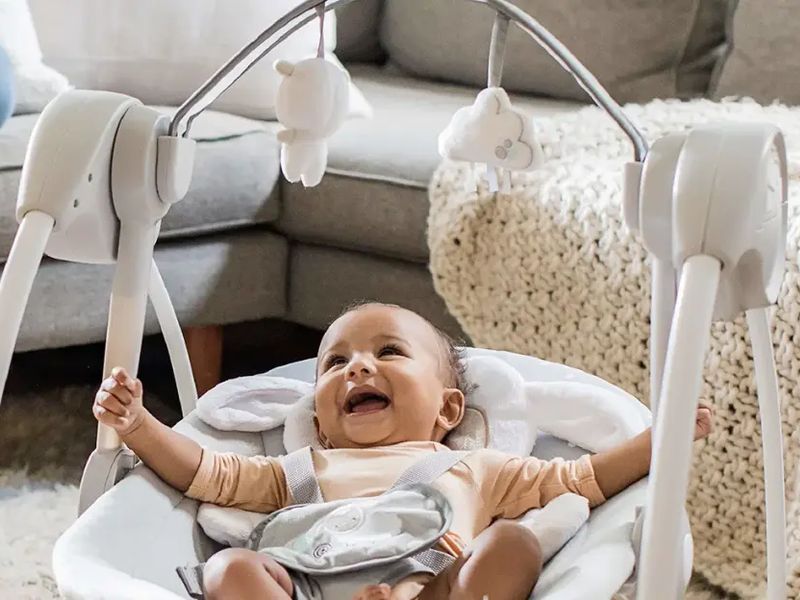
Baby Swing Safety: A Comprehensive Guide for UK Parents
As a parent in the UK, your child’s safety is undoubtedly your top priority. When it comes to using a baby swing, taking the necessary precautions is crucial to ensure your little one’s well-being. This comprehensive guide will explore why baby swing safety matters, how to choose the right swing, set up a safe environment, use the swing safely, and maintain it properly. By following these guidelines, you’ll create a secure and enjoyable swinging experience for your baby.
Understanding the Importance of Baby Swing Safety
Before delving into the specifics, it’s essential to understand why baby swing safety is so critical. As a parent, you want to provide your child with comfort and entertainment, but not at the expense of their safety. Here’s why prioritising baby swing safety is crucial:
- Preventing falls and injuries: Baby swings elevate your little one off the ground, increasing the risk of falls if not properly secured or supervised.
- Ensuring proper positioning and support: Correctly using safety features like straps and harnesses helps keep your baby secure and comfortable while swinging.
- Avoiding suffocation hazards: Incorrect positioning of blankets, pillows, or other items in the swing can pose a suffocation risk for infants.
- Maintaining a safe environment: By prioritising safety, you create a nurturing space where your baby can relax and enjoy their swinging experience without unnecessary risks.
Benefits of a Safe Baby Swing
When you invest in a safe baby swing and follow recommended safety guidelines, both you and your baby can enjoy numerous benefits:
- Promotes healthy development and relaxation: Swinging motions have a calming effect on babies, helping them relax and potentially aiding in better sleep patterns.
- Encourages a positive sleep routine: Many parents find that using a baby swing as part of their sleep routine can be helpful. However, it’s crucial to ensure the swing is safe and used appropriately to reduce any sleep-related risks.
- Provides a hands-free option for parents: Baby swings can offer you a much-needed break by providing a safe and secure space for your baby while you attend to other tasks or simply take a moment for yourself.
Choosing a Safe Baby Swing
Selecting the right baby swing for your child is a crucial decision. Not all baby swings are created equal when it comes to safety features and functionality. Here’s how you can choose a safe baby swing that meets your child’s needs while prioritising their safety:
Factors to Consider When Selecting a Baby Swing
- Weight and Age Limits: Check the weight and age limits specified by the manufacturer to ensure your baby falls within the recommended range. These limits are designed to ensure your baby’s safety and prevent any structural or mechanical issues with the swing.
- Stability and Sturdiness: Look for a baby swing with a solid base and sturdy construction. A stable swing reduces the risk of tipping or wobbling during use.
- Safety Features: Ensure that the swing has appropriate safety features such as straps and harnesses. These help secure your baby in place and prevent them from falling out or getting injured while swinging.
- Comfort and Support: Consider the padding, seat recline options, and overall comfort of the swing. A well-padded seat with adjustable recline positions can provide optimal support for your baby.
- British Safety Standards: Make sure the baby swing you choose complies with British safety standards. Look for certifications or labels indicating compliance with BS EN 16232:2013+A1:2018 for swings, bouncers, and recliners.
Types of Baby Swings and Their Safety Features
Baby swings come in various types, each with its own unique features and safety considerations. Understanding these types can help you choose the most suitable option for your child:
- Full-Size Swings: These swings typically have a sturdy frame and provide a range of swinging motions, from side-to-side to back-and-forth. Look for full-size swings with a wide base, strong frame, and reliable safety features such as a five-point harness to ensure your baby’s safety.
- Portable Swings: If you’re often on the go or have limited space in your home, a portable swing might be the ideal choice. These swings are compact and lightweight, making them easy to move around. When selecting a portable swing, prioritise stability, secure folding mechanisms, and safety features like adjustable harnesses.
- Rockers and Bouncers: While not traditional swings, rockers and bouncers offer alternative options for soothing your baby. Look for rockers and bouncers with safety harnesses, stable bases, and non-slip feet to prevent accidents.
When considering any type of baby swing, always prioritise safety features and the well-being of your child. It’s advisable to read reviews from other UK parents, seek recommendations from trusted sources, and consult UK-based resources to ensure you’re making an informed decision that aligns with the safety standards specific to the UK.
Setting Up a Safe Environment for Baby Swing Usage
Once you’ve chosen a safe baby swing, it’s crucial to create a secure environment for its use. Taking the time to prepare the space properly can significantly reduce the risk of accidents and ensure your baby’s safety.
Preparing the Space for Baby Swing Safety
Before placing your baby in the swing, follow these steps to prepare the surrounding area:
- Choose an Appropriate Location: Select a level surface that can accommodate the swing comfortably. Avoid placing the swing near stairs, sharp edges, or other potential hazards. Ensure the area is well-ventilated and at a comfortable temperature for your baby.
- Clear the Surrounding Area: Remove any objects that may pose a risk to your baby or interfere with the swing’s movement. Keep toys, furniture, cords, and other items at a safe distance. Pay particular attention to items that could fall or be pulled onto the swing.
- Check the Stability of Hooks or Frames: If you’re using a suspended swing, ensure that the hooks or frames used to hang the swing are secure and can bear the weight of both the swing and your baby. Follow the manufacturer’s instructions for proper installation, and consider having a professional install it if you’re unsure.
- Ensure Proper Lighting: Make sure the area where you place the swing is well-lit. This will help you monitor your baby easily and respond quickly if needed.
Safe Placement and Positioning of the Baby Swing
Proper placement and positioning of the baby swing are vital for your child’s safety and comfort. Consider the following guidelines when setting up the swing:
- Keep the Swing Away from Edges or Furniture: Ensure that the swing is positioned at a safe distance from walls, tables, or other furniture to prevent any accidental collisions or entrapment hazards. A good rule of thumb is to leave at least 1 metre of clear space around the swing.
- Proper Distance from Walls or Structures: Leave enough space between the swing and any nearby walls or structures. This prevents the swing from hitting or getting caught on surfaces during use.
- Avoid Potential Tipping Hazards: Ensure that the swing is placed on a stable surface and doesn’t pose a tipping risk. Make sure the swing’s base is on solid ground and there are no loose rugs or uneven surfaces underneath.
- Consider Room Traffic: Place the swing in an area where it won’t obstruct normal household traffic. This reduces the risk of someone accidentally bumping into the swing while your baby is in it.
- Keep Away from Heat Sources: Position the swing away from radiators, heaters, or direct sunlight to prevent your baby from overheating.
By carefully preparing the space and correctly positioning the baby swing, you create a safe environment where your baby can swing without unnecessary risks. Remember to periodically reassess the setup, especially as your baby grows and becomes more active.
Safe Practices When Using a Baby Swing
Now that you’ve set up a safe environment for your baby swing, it’s crucial to follow safe practices during use. These guidelines will help ensure that your baby’s swinging experience is both enjoyable and secure.
Guidelines for Safe Baby Swing Usage
- Always Supervise Your Baby: Never leave your baby unattended while they’re in the swing. Keep a watchful eye on them to ensure their safety and intervene if needed. Even if you’re using the swing to free up your hands for other tasks, make sure you can see and hear your baby at all times.
- Follow Manufacturer’s Instructions: Read and understand the manufacturer’s instructions before using the swing. Pay attention to weight limits, assembly instructions, and any specific safety recommendations provided. Keep the instruction manual in a safe place for future reference.
- Avoid Excessive Swinging Speeds and Angles: While it may be tempting to swing your baby at higher speeds or angles, it’s important to stick to moderate settings recommended by the manufacturer. Excessive speeds or angles can increase the risk of accidents and may overstimulate your baby.
- Use Age-Appropriate Settings: Many swings offer different speed and motion settings. Use settings appropriate for your baby’s age and development stage. Start with gentler settings for newborns and adjust as your baby grows.
- Limit Swing Usage Duration: Although swings can be a great source of comfort and entertainment for your baby, it’s important not to rely on them excessively. Limit the time your baby spends in the swing to avoid overstimulation and promote varied activities and interactions. A good rule of thumb is to limit swing sessions to 30 minutes at a time.
- Transition to Safe Sleep Environments: While some babies may fall asleep in the swing, it’s not recommended to let them sleep there for extended periods. If your baby falls asleep in the swing, gently move them to a safe sleep environment like a cot or Moses basket.
Additional Safety Tips for Baby Swing Usage
- Secure the Baby with Harness or Straps: Always use the provided safety harness or straps to secure your baby in the swing. Ensure that they are fastened properly to prevent your baby from slipping or falling out. Check that the straps are snug but not too tight, and that they’re positioned correctly across your baby’s body.
- Dress Your Baby Appropriately: Dress your baby in comfortable clothing that won’t get tangled in the swing’s straps or mechanism. Avoid loose clothing, strings, or accessories that could pose a choking hazard.
- Check Your Baby’s Position: Regularly check that your baby is positioned correctly in the swing. Their back should be well-supported, and their head should not slump forward. If your baby is too small for the swing, use appropriate infant inserts recommended by the manufacturer.
- Be Mindful of Swinging Duration: While swings can be soothing, it’s important not to let your baby become overly dependent on the motion. Gradually reduce swinging time as your baby grows and encourage other forms of play and interaction.
- Keep Pets Away: If you have pets, ensure they’re kept away from the baby swing to prevent any accidents or disturbances.
- Use on Ground Level: Always use the swing on the ground floor of your home to minimise the risk of falls from heights.
- Avoid Placing Items in the Swing: Don’t add blankets, toys, or other items to the swing unless specifically designed for use with it. These can pose suffocation or choking hazards.
Baby Swing Safety Maintenance and Troubleshooting
Proper maintenance of your baby swing is crucial for ensuring its ongoing safety and functionality. Regular checks and prompt addressing of any issues will help keep your baby’s swinging experience secure and enjoyable.
Caring for Your Baby Swing to Ensure Safety
Incorporate these maintenance tasks into your routine to keep the swing in optimal condition:
- Cleaning and Sanitising: Regularly clean the swing to prevent the buildup of dirt, dust, and bacteria. Follow the manufacturer’s instructions for cleaning methods and suitable products. Pay special attention to areas where spills or messes occur, such as the seat, straps, and frame. For fabric parts, check if they’re machine washable or require spot cleaning.
- Checking for Loose Parts: Routinely inspect the swing for any loose parts, including screws, nuts, or bolts. Tighten them if necessary to maintain the swing’s stability. If you notice any missing or damaged parts, contact the manufacturer for replacements or repairs.
- Inspecting Straps and Harnesses: Check the condition of the safety straps and harnesses to ensure they are secure and free from fraying or wear. Make sure the buckles function properly and that the straps are not twisted. Replace any damaged or worn-out straps promptly.
- Examining the Frame and Mechanisms: Regularly inspect the swing’s frame for any signs of damage, rust, or weakness. Check that all moving parts are functioning smoothly and that there are no unusual noises during operation.
- Storing the Swing Properly: If you plan to store the swing when not in use, follow the manufacturer’s instructions for proper storage. Disassemble it if necessary and store it in a clean, dry location to prevent damage. Cover the swing to protect it from dust and debris.
- Updating Firmware (for Electronic Swings): If your swing has electronic components, check for any firmware updates from the manufacturer and apply them as recommended.
Common Baby Swing Safety Concerns and Solutions
While baby swings are generally safe, certain concerns may arise during usage. Here are some common safety concerns and their solutions:
- Swing-Related Discomfort or Irritation:
- Ensure that your baby is properly positioned and supported in the swing.
- Check for any discomfort-inducing factors such as rough fabric or incorrect recline angles.
- Consider using additional padding or blankets to enhance your baby’s comfort, but ensure they don’t interfere with the safety harness.
- Swing Malfunctions or Technical Issues:
- If you notice any mechanical malfunctions, such as a malfunctioning motor or irregular swinging patterns, discontinue use immediately.
- Contact the manufacturer for troubleshooting assistance or professional repairs.
- Refrain from attempting to repair the swing yourself, as it may void the warranty or compromise safety.
- Battery or Power Issues:
- For battery-operated swings, ensure you’re using the correct type and size of batteries.
- Check that batteries are inserted correctly and replace them as needed.
- For mains-powered swings, inspect the power cord regularly for any damage and ensure it’s properly plugged in.
- Excessive Noise:
- Some level of noise is normal, but if you notice unusual or excessive sounds, check for loose parts or mechanical issues.
- Contact the manufacturer if the noise persists or seems abnormal.
- Stability Concerns:
- If the swing feels unstable, double-check that it’s assembled correctly and placed on a level surface.
- Avoid placing the swing on elevated surfaces or near edges.
Seeking Professional Help for Swing Repairs
If your swing requires repairs beyond your capabilities or expertise, it’s best to seek professional help:
- Contact the Manufacturer: Reach out to the manufacturer’s customer service for guidance. They may offer repair services or direct you to authorised repair centres in the UK.
- Consult a Certified Technician: If the warranty has expired, consider contacting a certified technician who specialises in baby product repairs.
- Avoid DIY Repairs: Refrain from attempting complex repairs yourself, as this could compromise the swing’s safety and potentially void any remaining warranty.
- Consider Replacement: If the swing is old or severely damaged, it might be safer and more cost-effective to replace it with a new model that meets current safety standards.
Remember, your baby’s safety is paramount. If you’re ever in doubt about the safety or functionality of your baby swing, err on the side of caution and discontinue use until you can have it professionally assessed or replaced.
Conclusion: Embracing Safe and Joyful Baby Swing Experiences
As you navigate the world of baby swings, remember that your commitment to safety is a testament to your love and care for your little one. By following the guidelines outlined in this comprehensive guide, you’re creating a secure environment where your baby can enjoy the soothing benefits of swinging while you enjoy peace of mind.
Key takeaways to remember:
- Choose a swing that meets UK safety standards and is appropriate for your baby’s age and weight.
- Set up the swing in a safe location, away from hazards and with plenty of clear space around it.
- Always supervise your baby when they’re in the swing and follow safe usage practices.
- Regularly maintain and inspect the swing to ensure it remains in good condition.
- Address any safety concerns promptly and seek professional help when needed.
As your baby grows and develops, their needs and abilities will change. Regularly reassess whether the swing is still appropriate for your child and adjust your safety measures accordingly. Remember, while baby swings can be wonderful tools for soothing and entertaining your little one, they should be used in moderation as part of a varied routine that includes plenty of floor time, tummy time, and direct interaction with you.
Trust your instincts as a parent and don’t hesitate to seek advice from healthcare professionals or trusted parenting resources if you have any concerns about your baby’s comfort or safety in the swing. Every baby is unique, and what works for one may not work for another.
By creating a safe swinging environment, you’re not just protecting your baby – you’re nurturing their development, comfort, and happiness. Here’s to many safe, joyful swinging experiences for you and your little one!






